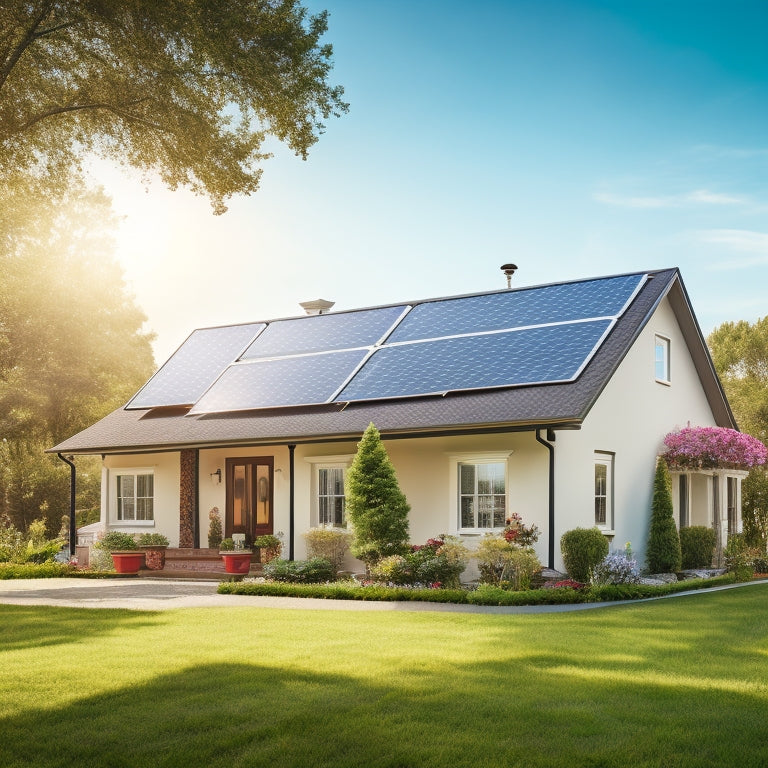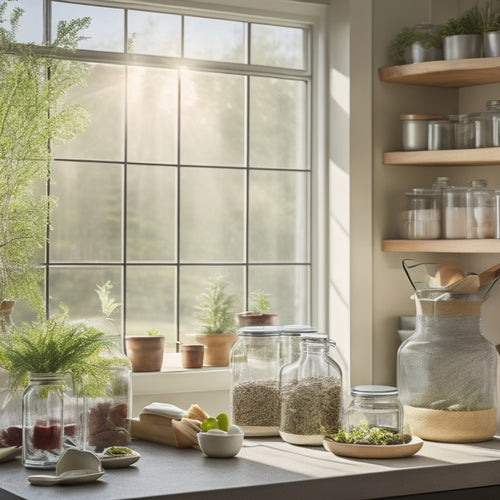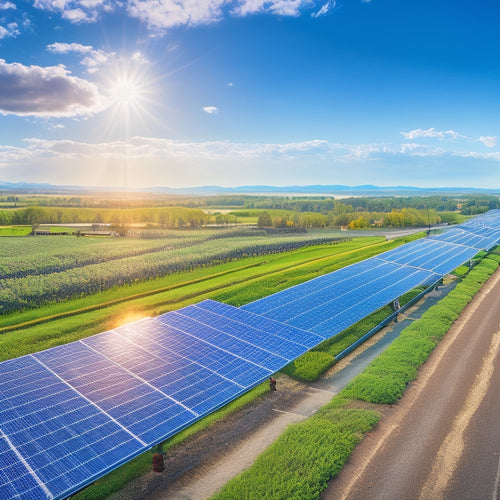
Cost of Solar Panels for My House
Share
You're considering installing solar panels on your house, and the cost is likely top of mind. The upfront investment varies depending on factors like system size, quality, and installation costs, ranging from $15,000 to $30,000 or more. However, with federal tax credits and financing options, you can offset installation costs. Plus, solar panels can increase your property value, potentially eliminating energy bills entirely. As you weigh the costs, keep in mind that optimizing energy production relies on efficient inverter technology, evaluating your roof's shading, and achieving a higher energy conversion rate - and there's more to investigate when it comes to maximizing your solar panel investment.
The Essentials
- The cost of solar panels for your house depends on the system size, quality, and installation company, with average costs ranging from $15,000 to $30,000.
- Federal tax credits can offset up to 26% of the total installation cost, making solar panels more affordable for homeowners.
- The cost of solar panels is reduced by the amount of electricity they generate, with an average annual savings of $400 to $1,000 on energy bills.
- Financing options, such as loans and leases, can make solar panels more accessible, with some options offering $0 down payment.
- The cost of solar panels can increase property value by up to 17%, making them a valuable investment for homeowners.
Zero Energy Bills Possible
You can greatly reduce your energy expenses by investing in solar panels, which capture renewable energy from the sun.
By generating your own electricity, you'll save money now and potentially eliminate your energy bills altogether.
With rooftop solar panels, you can elevate your home's energy efficiency and reduce your reliance on the grid.
As a clean and sustainable source of power, solar energy can also increase your property's value and reduce your carbon footprint.
Save Money Now
Almost 80% of homeowners who invest in solar panels do so to save money on their energy bills. You're likely no exception. By installing solar panels on your roof, you can greatly reduce your energy costs and even eliminate them entirely.
With solar panels, you generate your own electricity and rely less on the grid, which means lower bills. By embracing a cleaner, more sustainable future with Renewable Energy Solutions, you can tackle three major concerns at once: reducing your electricity bills, providing backup power during outages, and contributing to a healthier environment.
Plus, you can take advantage of tax incentives, such as the 26% federal tax credit, to offset the initial cost of installation. Additionally, various financing options are available to make solar panels more accessible and affordable. You can choose to pay cash upfront, finance through a loan, or even lease solar panels.
Renewable Energy Source
Solar panels employ the power of the sun, providing a renewable energy source that can greatly reduce your reliance on the grid. By capturing solar energy, you'll not only decrease your energy bills but also contribute to a more sustainable future.
This renewable energy source offers numerous sustainability benefits, including a significant reduction in greenhouse gas emissions and reliance on fossil fuels. With an extensive solar power system for your house, you can eliminate the worry of rising electricity bills, solving the problem of sky-high energy costs that strain your budget every month.
Additionally, solar power for your house eliminates reliance on the grid, providing a reliable and independent source of energy, perfect for those in areas prone to power outages or off-grid living.
Unlike traditional energy sources, solar power is clean, non-polluting, and abundant. By going solar, you'll reduce your carbon footprint and help combat climate change.
As a homeowner, you have the power to choose a cleaner, more sustainable energy source. By switching to solar, you'll enjoy the freedom from rising energy costs and the satisfaction of doing your part for the environment.
With solar panels, you can potentially eliminate your energy bills and enjoy a more sustainable, energy-independent lifestyle.
Increased Property Value
When you install solar panels, you can expect a significant increase to your property's value.
With the growing demand for eco-friendly homes, solar panels have become a sought-after feature in modern real estate. You'll likely see a higher selling price, thanks to the increased demand for eco-friendly homes and the savings that come with renewable energy.
Additionally, the improved curb appeal of solar panels can make your property stand out from the competition, further enhancing its appeal to potential buyers.
Higher Selling Price
Installing solar panels can enhance your property's selling price by up to 17%, according to a study by the National Renewable Energy Laboratory. This increase in value is attributed to the growing demand for eco-friendly homes and the solar incentives offered by governments and utilities. As a homeowner, you can benefit from these incentives and attract potential buyers who are willing to pay a premium for solar-powered homes.
The table below illustrates the average increase in property value based on the size of the solar panel system:
| System Size (kW) | Average Increase in Property Value | ROI (Return on Investment) |
|---|---|---|
| 3-5 kW | 10-12% | 100-120% |
| 5-10 kW | 12-15% | 120-150% |
| 10+ kW | 15-17% | 150-170% |
Improved Curb Appeal
Enhancing your property's curb appeal can greatly increase its value, and solar panels are a key element in this process. A well-designed solar panel system can raise your home's visual appeal, making it stand out in the neighborhood.
Modern solar panels feature sleek, streamlined designs that seamlessly integrate into your roof's structure. Their clean lines, minimalist frames, and high-efficiency cells create a sophisticated look that adds to your home's aesthetic charm.
The solar panel aesthetics can greatly improve your neighborhood appeal, making your property more desirable to potential buyers. According to the National Renewable Energy Laboratory, homes with solar panels sell for approximately $15,000 more than similar homes without them.
This increased value is largely due to the perceived benefits of solar energy, including reduced energy costs, environmental sustainability, and a modern, high-tech appearance. By investing in a high-quality solar panel system, you're not only reducing your carbon footprint but also enhancing your property's value and appeal.
Efficient Inverter Technology Explained
You're likely aware that inverters play an essential role in solar panel systems, converting DC power into usable AC power for your home.
When it comes to efficient inverter technology, you're looking for high conversion efficiency and maximum energy harvest.
As renewable energy systems continue to advance, reliable power backup solutions are becoming increasingly important to guarantee a stable and efficient energy supply.
These two key aspects will greatly impact the overall performance and returns on your solar investment.
High Conversion Efficiency
Within the domain of solar panel technology, high conversion efficiency is a critical factor in determining the overall performance of a solar panel system. You want to maximize the amount of energy your system produces, and high conversion efficiency is key to achieving that. This refers to the ability of your solar panels to convert sunlight into usable electricity.
The conversion efficiency of your solar panels depends on the type of solar panel materials used in their construction. For instance, monocrystalline silicon panels tend to have higher efficiency ratings than polycrystalline silicon panels.
When shopping for solar panels, you'll often see efficiency ratings listed as a percentage. A higher percentage indicates a more efficient panel.
You should look for solar panels with high efficiency ratings to guarantee you're getting the most out of your system. While more efficient panels may be more expensive upfront, they can pay off in the long run by producing more energy and saving you money on your electricity bills.
Maximum Energy Harvest
Maximum Energy Harvest (Efficient Inverter Technology Explained)
Utilizing maximum energy from your solar panel system requires more than just high-efficiency panels; it also demands a sophisticated inverter technology that can optimize energy production. This advanced technology guarantees you get the most out of your solar panel system, even when the sun isn't shining brightly.
You'll want an inverter that can track the maximum power point of each string of panels, adjusting to changing conditions like cloud cover or seasonal variations. This maximizes energy output, even with suboptimal solar panel placement or non-optimal tilt.
Look for an inverter with a high maximum power point tracking (MPPT) efficiency to confirm you're capturing every available kilowatt-hour.
Additionally, consider an inverter with advanced monitoring capabilities, allowing you to track performance in real-time and identify potential issues before they impact your energy production.
Assess Your Roof's Shading
When evaluating your roof's shading, you'll need to identify obstructions that can cast shadows on your solar panels, such as skylights, vents, and chimneys.
Additionally, it's crucial to take into account the benefits of off-grid renewable energy solutions, which can provide energy independence and cost savings.
You'll also want to calculate the amount of shaded area on your roof, as this will impact the system's overall energy production.
Roof Obstructions to Consider
Frequently, homeowners overlook roof obstructions that can greatly impact the performance of their solar panel system. You need to assess your roof's shading to identify potential obstructions that may affect the installation and efficiency of your solar panels.
Start by evaluating your roof's pitch, as a steep roof can create installation challenges. Additionally, take into account the presence of vents, skylights, and chimneys, which can cast shadows on your solar panels and reduce their energy output.
Other obstructions to take into account include roof-mounted equipment such as HVAC units, satellite dishes, and antennas. These obstructions can't only cast shadows but also make it difficult to install solar panels. You may need to relocate or remove these items to guarantee a successful installation.
Furthermore, nearby trees or buildings can also cast shadows on your roof, further reducing the effectiveness of your solar panel system. By identifying and addressing these roof obstructions, you can guarantee a smooth installation process and maximize the energy output of your solar panels.
Amount of Shaded Area
You've assessed your roof's obstructions, now it's time to evaluate the amount of shaded area on your roof. Shading can greatly impact your solar panel system's performance, so it's crucial to understand the extent of the shaded area.
| Shading Source | Shaded Impact |
|---|---|
| Trees | 10-20% reduction in energy output |
| Neighboring Buildings | 5-15% reduction in energy output |
| Roof Features (vents, skylights) | 2-5% reduction in energy output |
To mitigate the shaded impact, you can consider shading solutions such as:
- Trimming or removing trees that cast shade on your roof
- Installing a microinverter or power optimizer system to optimize energy output from individual panels
- Using a solar panel system design that minimizes the effect of shading on overall energy output
Higher Energy Conversion Rate
You're likely looking for solar panels that can generate the maximum power output from the sun's energy.
A higher energy conversion rate guarantees you get the most out of your solar panel investment.
With higher-efficiency panels, you can expect a greater maximum power output, which translates to more electricity and cost savings.
Maximum Power Output
Maximum power output, measured in watts (W), refers to the highest amount of electrical power a solar panel can produce under ideal conditions. When evaluating solar panels for your house, understanding maximum power output is vital in determining your energy needs. You want to guarantee that your solar panel system can generate enough electricity to power your home comfortably.
The maximum power output of a solar panel depends on its capacity, which is typically measured in watts peak (Wp). A higher solar panel capacity generally means higher energy production. However, energy production factors such as temperature, humidity, and shading can affect the actual energy output.
To get an accurate estimate of your solar panel's maximum power output, you'll need to take into account these factors and adjust the calculations accordingly.
When selecting a solar panel system, look for a high maximum power output to make certain you're getting the most energy out of your investment. By understanding the maximum power output of your solar panels, you can enjoy the freedom of generating your own clean energy and reducing your reliance on the grid.
Frequently Asked Questions
Can I Install Solar Panels on My Own?
You can attempt a DIY installation, but you'll need to take into account safety concerns like electrical shock, falls, and roof damage; it's recommended to hire a professional to guarantee a safe and efficient installation that meets local building codes.
Do Solar Panels Work During Power Outages?
When the grid goes dark, you're left in the dark - unless you've got a solar panel system with a battery backup, that is. You'll capture the sun's power, even during power outages, with a seamless shift to solar panel functionality.
Are Solar Panels Resistant to Hail and Extreme Weather?
You're wondering if solar panels can withstand harsh conditions. Yes, they're designed to resist hail damage and extreme weather. Manufacturers test panels to guarantee they can endure high winds, heavy snow, and even golf-ball-sized hailstones, giving you peace of mind and energy independence.
Can I Sell Excess Energy Back to the Grid?
"When life gives you lemons, make lemonade" - and with solar panels, you can sell excess energy back to the grid through net metering, earning energy credits that offset your bills, giving you more freedom and control over your energy usage.
How Long Does It Take to Install Solar Panels?
You'll typically spend 2-5 days overseeing the installation process, depending on your system's size and complexity, but the actual installation timeline can vary from a few hours to several weeks, contingent on permits and inspections.
Final Thoughts
Now that you've weighed the benefits of solar panels for your house, it's time to shine a light on the costs. Think of your roof as a canvas, waiting for the brushstrokes of solar panels to paint an image of energy independence. With efficient inverter technology and careful assessment of your roof's shading, you can capture the power of the sun to illuminate your path to zero energy bills and increased property value.
Related Posts
-

How to Achieve a Zero-Waste Lifestyle for a Greener Tomorrow
To achieve a zero-waste lifestyle, start by adopting the principles of refusing, reducing, reusing, and recycling. Sw...
-

Applications of Photovoltaic Systems
Photovoltaic systems are versatile, converting sunlight into electricity for various applications. You can use them i...
-

Top-Rated Home Solar Power Kits for Achieving Energy Independence
Top-rated home solar power kits enable you to achieve energy independence by greatly cutting your energy costs. You c...


